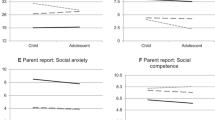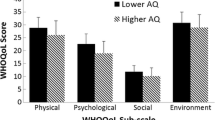Abstract
Loneliness and perceived social support were examined in 39 adolescent boys with autism spectrum disorders (ASD) by means of a self-labeling loneliness measure, the UCLA Loneliness Scale (third version), and the Social Support Scale for Children. Twenty-one percent of the boys with ASD described themselves as often or always feeling lonely. Compared with 199 boys from regular schools in a national probability study, ASD was strongly associated with often or always feeling lonely (OR: 7.08, p < .0005), as well as with a higher degree of loneliness (F(1,229) = 11.1, p < .005). Perceived social support from classmates, parents, and a close friend correlated negatively with loneliness in ASD. The study, therefore, indicates a high occurrence of loneliness among adolescent boys with ASD and points at perceived social support as an important protective factor.
Similar content being viewed by others
References
American Psychiatric Association. (2000). Diagnostic and statistical manual of mental disorders (DSM-IV-TR) (4th ed.). Washington, DC: American Psychiatric Press.
Barry, T. D., Klinger, L. G., Lee, J. M., Palardy, N., Gilmore, T., & Bodin, S. D. (2003). Examining the effectiveness of an outpatient clinic-based social skills group for high-functioning children with autism. Journal of Autism and Developmental Disorders, 33, 685–701.
Bauminger, N., & Kasari, C. (2000). Loneliness and friendship in high-functioning children with autism. Child Development, 71, 447–456.
Bauminger, N., & Kasari, C. (2001). The experience of loneliness and friendship in autism: Theoretical and practical issues. In E. Schopler, N. Yirmiya, C. Shulman, & L. M. Marcus (Eds.), The research basis for autism intervention (pp. 151–168). New York: Kluwer Academic/Plenum.
Bauminger, N., Shulman, C., & Agam, G. (2003). Peer interaction and loneliness in high-functioning children with autism. Journal of Autism and Developmental Disorders, 33, 489–507.
Bauminger, N., Shulman, C., & Agam, G. (2004). The link between perceptions of self and of social relationships in high-functioning children with autism. Journal of Developmental and Physical Disabilities, 16, 193–214.
Berthoz, S., & Hill, E. L. (2005). The validity of using self-reports to assess emotion regulation abilities in adults with autism spectrum disorder. European Psychiatry, 20, 291–298.
Bishop, S. L., Richler, J., Cain, A. C., & Lord, C. (2007). Predictors of perceived negative impact in mothers of children with autism spectrum disorder. American Journal on Mental Retardation, 112, 450–461.
Bunting, B. P., Adamson, G., & Mulhall, P. (2002). A Monte Carlo examination of an MTMM model with planned incomplete data structures. Structural Equation Modeling, 9, 369–389.
Cacioppo, J. T., Hughes, M. E., Waite, L. J., Hawkley, L. C., & Thisted, R. A. (2006). Loneliness as a specific risk factor for depressive symptoms: Cross-sectional and longitudinal analyses. Psychology and Aging, 21, 140–151.
Capps, L., Sigman, M., & Yirmiya, N. (1997). Self-competence and emotional understanding in high-functioning children with autism. In M. E. Hertzig & E. A. Farber (Eds.), Annual progress in child psychiatry and child development, 1996 (pp. 260–279). Hove, UK: Psychology Press.
Chamberlain, B., Kasari, C., & Rotheram-Fuller, E. (2007). Involvement or isolation? The social networks of children with autism in regular classrooms. Journal of Autism and Developmental Disorders, 37, 230–242.
Diamantopoulou, S., Henricsson, L., & Rydell, A. (2005). ADHD symptoms and peer relations of children in a community sample: Examining associated problems, self-perceptions, and gender differences. International Journal of Behavioral Development, 29, 388–398.
Eriksen, M. E. (2005). Interview af personer med særlige forudsætninger. [Interviewing people with special cognitive abilities]. Nyhedsbrev. Center for Kvalitativ Metodeudvikling, 38, 40–55.
Ghaziuddin, M., Weidmer-Mikhail, E., & Ghaziuddin, N. (1998). Comorbidity of Asperger syndrome: A preliminary report. Journal of Intellectual Disability Research, 42, 279–283.
Goswick, R. A., & Jones, W. H. (1982). Components of loneliness during adolescence. Journal of Youth and Adolescence, 11, 373–383.
Harter, S. (1985). Manual for the social support scale for children. Denver, CO: University of Denver.
Heiman, T. (2005). An examination of peer relationships of children with and without attention deficit hyperactivity disorder. School Psychology International, 26, 330–339.
Heinrich, L. M., & Gullone, E. (2006). The clinical significance of loneliness: A literature review. Clinical Psychology Review, 26, 695–718.
Hill, E., Berthoz, S., & Frith, U. (2004). Brief report: Cognitive processing of own emotions in individuals with autistic spectrum disorder and in their relatives. Journal of Autism and Developmental Disorders, 34, 229–235.
Kaminsky, L., & Dewey, D. (2002). Psychosocial adjustment in siblings of children with autism. Journal of Child Psychology and Psychiatry, 43, 225–232.
Kanner, L. (1943). Autistic disturbances of affective contact. Nervous Child, 2, 217–250.
Knott, F., Lewis, C., & Williams, T. (1995). Sibling interaction of children with learning disabilities: A comparison of autism and Down’s syndrome. Journal of Child Psychology and Psychiatry, 36, 965–976.
Lasgaard, M. (2007). Reliability and validity of the Danish version of the UCLA Loneliness Scale. Personality and Individual Differences, 42, 1359–1366.
Luther, E. H., Canham, D. L., & Cureton, V. Y. (2005). Coping and social support for parents of children with autism. Journal of School Nursing, 21, 40–47.
Mahon, N. E., Yarcheski, A., Yarcheski, T. J., Cannella, B. L., & Hanks, M. M. (2006). A meta-analytic study of predictors for loneliness during adolescence. Nursing Research, 55, 308–315.
Margalit, M., & Al-Yagon, M. (2002). The loneliness experience of children with learning disabilities. In B. Y. L. Wong & M. L. Donahue (Eds.), The social dimensions of learning disabilities (pp. 53–75). Mahwah, NJ: Erlbaum.
McNamara, J. K., Willoughby, T., & Chalmers, H. (2005). Psychosocial status of adolescents with learning disabilities with and without comorbid attention deficit hyperactivity disorder. Learning Disabilities Research and Practice, 20, 234–244.
Orsmond, G. I., Krauss, M. W., & Seltzer, M. M. (2004). Peer relationships and social and recreational activities among adolescents and adults with autism. Journal of Autism and Developmental Disorders, 34, 245–256.
Parkhurst, J. T., & Asher, S. R. (1992). Peer rejection in middle school: Subgroup differences in behavior, loneliness, and interpersonal concerns. Developmental Psychology, 28, 231–241.
Pedersen, S., Vitaro, F., Barker, E. D., & Borge, A. I. H. (2007). The timing of middle-childhood peer rejection and friendship: Linking early behavior to early-adolescent adjustment. Child Development, 78, 1037–1051.
Peplau, L. A., & Perlman, D. (1982). Perspectives on loneliness. In L. A. Peplau & D. Perlman (Eds.), Loneliness. A sourcebook of current theory, research and therapy (pp. 1–18). New York: Wiley.
Russell, D. W. (1996). UCLA Loneliness Scale (version 3): Reliability, validity, and factor structure. Journal of Personality Assessment, 66, 20–40.
Shaver, P. R., & Brennan, K. A. (1991). Measures of depression and loneliness. In J. P. Robinson, P. R. Shaver, & L. S. Wrightsman (Eds.), Measures of personality and social psychological attitudes (pp. 195–290). San Diego, CA: Academic Press.
Shtayermman, O. (2007). Peer victimization in adolescents and young adults diagnosed with Asperger’s syndrome: A link to depressive symptomatology, anxiety symptomatology and suicidal ideation. Issues in Comprehensive Pediatric Nursing, 30, 87–107.
Sutton, S. K., Burnette, C. P., Mundy, P. C., Meyer, J., Vaughan, A., Sanders, C., et al. (2005). Resting cortical brain activity and social behavior in higher functioning children with autism. Journal of Child Psychology and Psychiatry, 46, 211–222.
Tsao, L., & Odom, S. L. (2006). Sibling-mediated social interaction intervention for young children with autism. Topics in Early Childhood Special Education, 26, 106–123.
Volkmar, F., Chawarska, K., & Klin, A. (2005). Autism in infancy and early childhood. Annual Review of Psychology, 56, 315–336.
White, S. W., Keonig, K., & Scahill, L. (2007). Social skills development in children with autism spectrum disorders: A review of the intervention research. Journal of Autism and Developmental Disorders, 37, 1858–1868.
Wing, L. (1992). Manifestations of social problems in high-functioning autistic people. New York: Plenum.
World Health Organization. (1994). WHO ICD-10: Psykiske lidelser og adfærdsmæssige forstyrrelser: Klassifikation og diagnostiske kriterier [WHO ICD-10: Mental disorders and behavioural disorders: Classification and diagnostic criteria]. Copenhagen, Denmark: Munksgaard.
Acknowledgments
We are grateful for the assistance provided by the staff and students from Langagerskolen, Aarhus and Firkløverskolen, Randers.
Author information
Authors and Affiliations
Corresponding author
Rights and permissions
About this article
Cite this article
Lasgaard, M., Nielsen, A., Eriksen, M.E. et al. Loneliness and Social Support in Adolescent Boys with Autism Spectrum Disorders. J Autism Dev Disord 40, 218–226 (2010). https://doi.org/10.1007/s10803-009-0851-z
Received:
Accepted:
Published:
Issue Date:
DOI: https://doi.org/10.1007/s10803-009-0851-z




